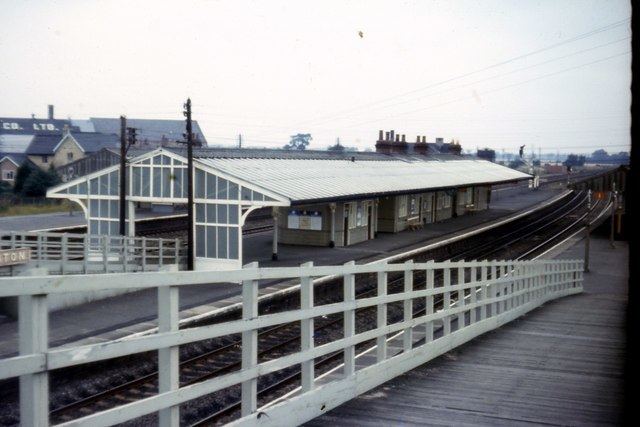Station code CHF DfT category F2 Number of platforms 4 | Grid reference SE509369 Managed by Northern 2011/12 72,906 | |
 | ||
Similar Ulleskelf railway station, South Milford railway st, Micklefield railway station, Sherburn‑in‑Elmet railway station, Cross Gates railway st | ||
Church fenton railway station inc flying scotsman
Church Fenton railway station serves Church Fenton in North Yorkshire, England. It is on the former York and North Midland Railway main line from York to Normanton, just under 10.75 miles (17 km) from York.
Contents
- Church fenton railway station inc flying scotsman
- Church fenton railway station june 2010
- History
- Services
- References
Church fenton railway station june 2010
History
The Y&NMR opened the first part of its route through the village (and on as far as Milford) on 29 May 1839, completing it the following year. On completion of a branch from there to Harrogate via Wetherby and Tadcaster by the Y&NM in 1848 a new station on a slightly different site gave it new importance and within two years it had become a calling point on the new East Coast Main Line from York to London with the opening of a line from Burton Salmon to Knottingley (trains then continuing via Askern and Doncaster).
Further development of the station occurred in 1869, when a 5-mile (8.0 km) link was opened by the North Eastern Railway from there to Micklefield on the former Leeds and Selby Railway to create a new main line between Leeds and York. The NER had been looking to shorten the previous, indirect route between the two cities via Castleford for some time prior to this, but plans to build a line via Tadcaster had come to nothing and so this alternative route was chosen. The existing line from here to York was subsequently quadrupled to handle the increased levels of traffic and the station substantially altered, with the addition of extra platforms and connections between the two pairs of lines. The station lost its ECML status in 1871 when the new direct line from York to Doncaster via Selby was opened, but trains from London to Harrogate continued to call and yet another addition to the list of routes serving the station came in 1879 when the Swinton and Knottingley Joint Railway line via Pontefract Baghill and Ferrybridge was opened. In connection with the quadrupling of the lines the present station was opened in 1904 slightly south of the second station.
Today the station remains busy, even though the Harrogate line fell victim to the Beeching Axe in January 1964 and passenger trains towards Castleford ended six years later. The Leeds to York Line carries a frequent passenger service (including CrossCountry and First TransPennine Express services) whilst the line towards Sherburn, Milford Junction and thence to Knottingley, Castleford and Pontefract carries large quantities of freight. However, only certain trains on the Northern operated Leeds to York, Dearne Valley and Hull to York routes actually call at the station's four platforms due to the relatively small size of the village it serves.
The station is covered by a Ditra Systems Public Address System (PA), voiced by Phil Sayer. Passenger information screens are also installed, but it is unstaffed and travellers must buy their tickets in advance or on the train. Access to all four platforms is via footbridge, so there is no step-free access to any of the platforms.
Services
Currently the station is served every two hours (hourly in the peaks) on weekdays by trains on the York to Leeds route (most of which continue to Bradford Interchange and Blackpool) and by a limited service on the York to Sheffield line (two trains per day each way) and towards Selby and Hull (one northbound and two southbound trains each way, peak hours only). Sundays see a two-hourly service to Leeds & York and two trains each way on the Dearne Valley line.
